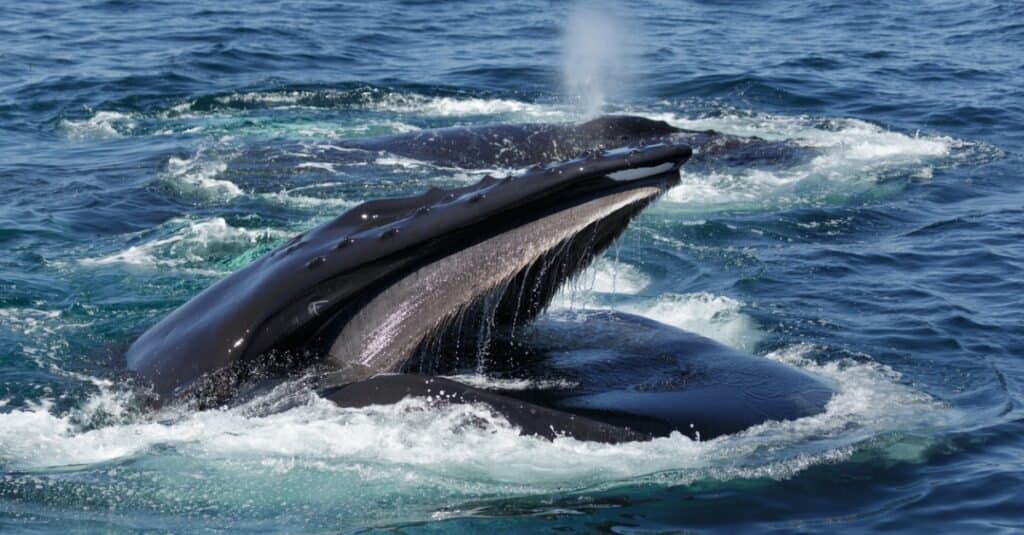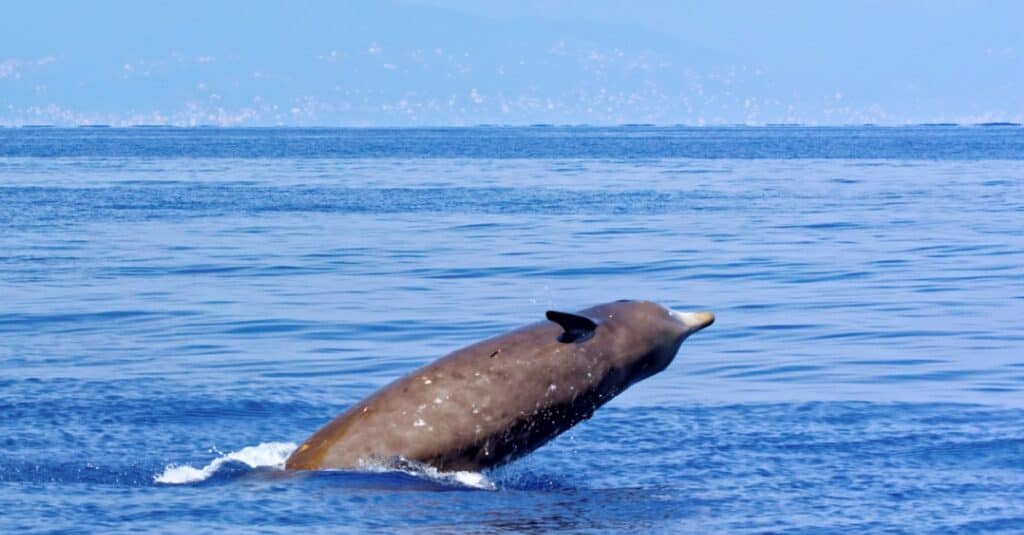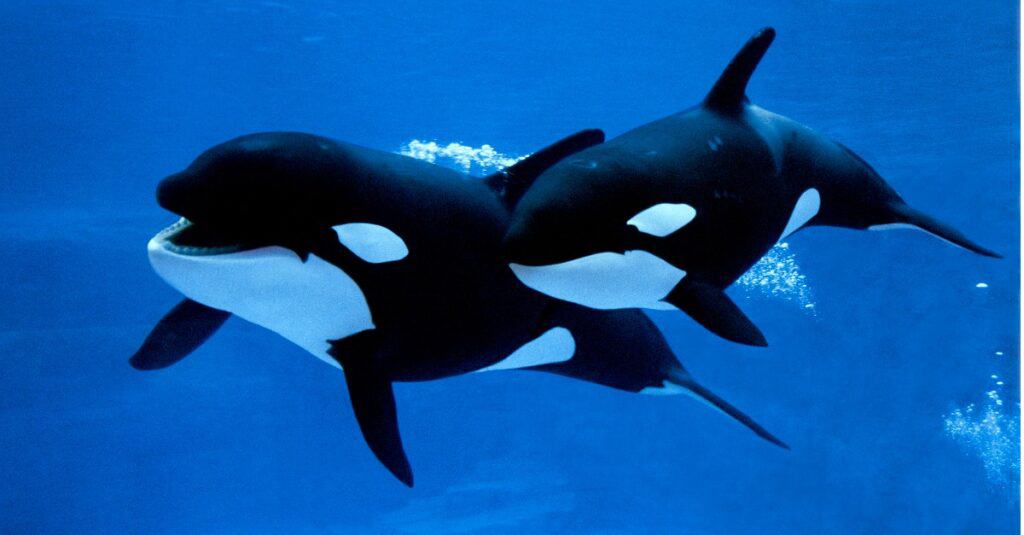How Long Can A Whale Stay Under Water
Whales travel through the body of water, lunging, leaping, and playing, with grace and swiftness that belies their huge size. The cloak-and-dagger to their incredible lifestyle, besides their well-adapted skeletal and muscular structure, is a very unique respiratory system specialized for deep-sea diving. In the course of its development, this respiratory system has had to overcome the challenges of mammalian anatomy. Just similar any other mammal, whales need oxygenated air to survive. They have a set of big, complex lungs that constantly exchange fresh oxygen for carbon dioxide to stay alive. Considering whales lack gills, they cannot draw oxygen directly from the h2o. This leaves them vulnerable to suffocation if they don't render to the surface in time. Fortunately, cetaceans accept evolved several extreme adaptations to survive the long and difficult journeying below the surface. Read on to learn virtually how long whales can agree their breath.
How Does a Whale Breathe?

The well-nigh important feature of whatsoever cetacean respiratory system (whether information technology's the sperm whale, humpback whale, killer whale, etc.) is the blowhole located at the top of the head. The blowhole remains airtight by default to forbid h2o from entering the trunk. After returning to the surface, the whale opens up its blowhole by contracting a small muscular flap; information technology and then exhales stale air from its body in a towering gust of pressurized air. The spout of h2o you see arising from the blowhole isn't coming from the lungs. Instead, the exhalation from the blowhole is then powerful that information technology sends the surrounding water from the surface of the torso upwardly into a fine mist in the air.
Once the stale air has been expelled from the body, the whale will accept in a series of quick breaths to furnish its oxygen. Most species but resurface for a few minutes before they relax the muscles around the blowhole once again and then swoop back beneath the surface. In society to go along h2o out of their lungs when they're eating, cetaceans mostly do not breathe through their mouths. All the same, scientists accept constitute that some dolphins with damaged blowholes tin learn to exhale through the mouth as a final resort.
How Long Tin a Whale Holds Its Breath?
The answer to that question definitely depends on the species (as well equally the individual). One of the well-nigh impressive of all the cetacean divers is the sperm whale (the species with a big rectangular-shaped head). It can concur its breath for around 90 minutes while diving down to depths of more than three,000 feet to banquet upon a favorite meal, giant squids.
The sperm whale isn't the only impressive cetacean diver though. The blue whale (the largest animal to have ever existed) tin can concord its breath for up to 90 minutes and usually resurface afterward near 30 minutes; the deepest dive ever recorded from a blue whale was effectually 1,000 feet below the surface.
The humpback whale (whose most obvious characteristic is the large hump on its back) can hold its jiff upward to an hr at a fourth dimension, but the typical foraging trip lasts an average of about four to vii minutes. It comes up to the surface, takes six to eight quick breaths, and then dives back downward. The deepest humpback whale dive ever recorded was more 600 anxiety.
The killer whale, by contrast, does much of its hunting near the surface. This is reflected in its respiratory capacity: it can only hold its breath for about an average of 15 minutes. Still, when prey isn't that like shooting fish in a barrel to find near the surface, the killer whale does take the ability to swoop several hundred feet below the surface in search of suitable prey. It volition surface virtually every iii to five minutes while traveling long distances.
Humans, by comparison, accept much weaker animate chapters. The boilerplate person can merely hold their breath for a few minutes at a time. The longest human being swoop e'er recorded, involving years of all-encompassing grooming, was prepare by Croatian diver Budimir Sobat in 2021. He held his jiff for an astonishing 24 minutes and 37 seconds.
What is the record for the longest whale dive?

iStock.com/HeitiPaves
The Cuvier's beaked whale, a deep bounding main species which can grow upward to 23 feet long and counterbalance up to 6,800 pounds, holds the record for the longest always cetacean dive. Capable of reaching depths of nearly 10,000 feet, this beaked whale is continuously setting new (human-observed) records. In 2014, a tagged whale was idea to remain underwater for about 138 minutes earlier information technology finally resurfaced. This record stood for near vi years until some other whale was observed in 2020 completing a dive of more than than three hours.
Cuvier's beaked whale is an interesting species for marine biologists to study. It'southward estimated that they spend effectually 90% of the time beneath the surface, maybe more than any other mammal. This appears to be pushing the very limits of what whales are capable of indelible, and information technology'due south not entirely clear why.
How does a whale hold its breath?
The secret to the whale's breathing chapters lies in the efficiency of the entire respiratory organisation. This starts from the moment of their start breath. While humans can but absorb nigh v percent oxygen with each breath, whales tin easily absorb upwards to 90% oxygen, which allows them to derive more than ability with each breath taken.
Opposite to what some people believe, whales do not take bigger lungs (at to the lowest degree in relation to their total body size). Instead, they rely on several other incredible adaptations to survive deep underwater dives. For instance, the blood book coursing through their veins flows on a massive calibration: it'southward maybe 3 to four times the amount of blood compared to a terrestrial mammal of a similar size. Their blood also contains twice the level of oxygen-carrying hemoglobin as other mammals. This means their claret is particularly oxygen-rich in order to supply their hungry cells.
When whales dive into the water, their bodies volition automatically redirect blood flow to vital central organs such as the encephalon and muscles and away from any organs they aren't using at the moment, including the kidneys and liver. With just the almost vital organs still operable, whales can wearisome their middle rates down to around four to 8 beats per infinitesimal, just enough to stay alive. The blue whale provides a particularly farthermost example of this. Information technology tin can apparently reduce its heart rate to almost 2 beats per minute.
Finally, if all else fails and information technology'southward running out of oxygen stores, a whale tin can always switch to anaerobic respiration, which saves precious oxygen but does cause lactic acid to build up quickly, which tires out the muscles. This is commonly an option of terminal resort; about whales accept already completed more than 90% of their dive before they e'er switch to anaerobic respiration. One notable exception (once more) is the Cuvier's beaked whale. Information technology can apparently stay underwater for at least another 60 minutes afterwards anaerobic respiration kicks in without experiencing much credible musculus fatigue. This may propose there's something unusual occurring within the beaked whale's metabolism that scientists don't yet understand.
One important issue that any deep-sea diver must contend with (whether man or whale or anything else) is tissue damage. Small differences in pressure between gas-filled air cavities within the body (such as the lungs or inner ear) and the surrounding water can cause the tissue to rupture. This is usually known in the scientific jargon every bit barotrauma. In order to withstand the pressure of a deep dive, it's believed that some whales have extra veins lining the insides of these gas-filled cavities. When the whale reaches exceptional depths, the veins will then aggrandize outward to fill the extra space inside of the crenel. At the same time, the lungs will collapse to prevent whatever harm to them. Since they accept so much oxygen flowing through their blood, they don't need to use their lungs anymore until reaching the surface again.
How do whales slumber without suffocating?

Cetaceans generally have 2 different strategies for sleeping. They volition either rest horizontally or vertically in the water, or they volition catch a bit of sleep while swimming adjacent to some other individual. Both of these methods involve slumber states that are more akin to napping; much of their brain remains alert and active. While breathing itself is an involuntary activity, whales must remain conscious plenty to command the blowhole because it requires voluntary muscle movement. This suggests they don't exactly sleep in the way humans practise.
Can whales drown?
Whales don't actually drown (because their lungs almost never fill with water), but they tin can suffocate for a lack of oxygen. This can occur when a whale becomes entangled in a angling cyberspace and, in a panic, attempts to dive deeper or remains stuck in place. Newborns can also struggle to reach the surface. Sometimes they volition suffocate earlier taking their first jiff.
Adjacent Up: Guinea Squealer Names: Male child and Girl Names for Your Guinea Pig
How Long Can A Whale Stay Under Water,
Source: https://a-z-animals.com/blog/how-long-can-whales-hold-their-breath/
Posted by: rossarishe.blogspot.com


0 Response to "How Long Can A Whale Stay Under Water"
Post a Comment